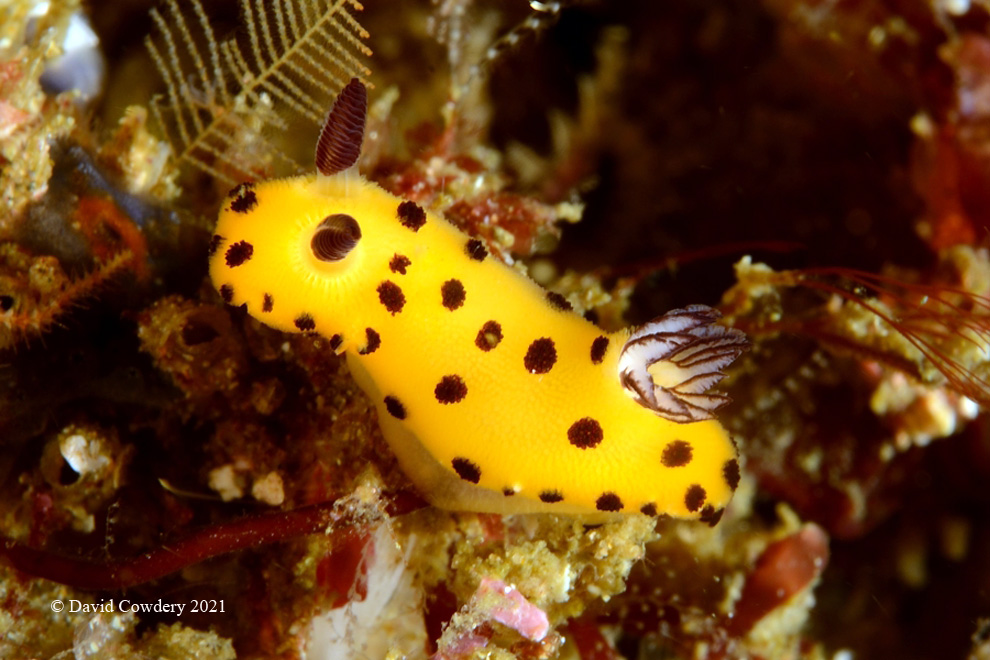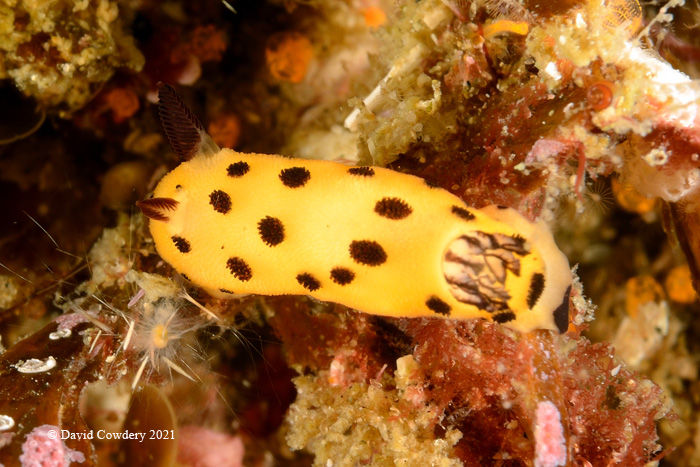 |
Image courtesy of David Cowdery
Byron Bay Australia
Image courtesy of Dave Behrens |
Jorunna sp. (maybe undescribed) Sometime back Dave Cowdery sent us this guy from Australia. He told us - "...According to an Australian Geographic website, there is some thought that this animal which resembles Jorunna parva is in fact a new species. In my opinion, this is correct. I have included two images taken at Byron Bay Australia. The original article was discussing Jorunna under the heading "Cute sea bunnies" and showed funebris and parva as well as the not quite parva. In my view this animal looks like a cross between funebris and parva. The animal appears on the "Nudibranchs of the Sunshine Coast" as Jorunna sp 3, so they think it is a new species..." Mike and I agree with Dave as the black patches of tubercles on the dorsum of Dave's specimen contain multiple caryophyllidia, more like J. funebris, not single tubercles as in J. parva. The gill is also different. Hard to tell with some of these guys. Need specimens and genetic analysis. Good show Dave. Dave Behrens Sammamish, WA 98074 May., 2021 Send Dave email at davidwbehrens@gmail.com |

Dave Cowdery is a retired bio-medical Engineer and is the inventor of the Alumina/Titanium hermetic feedthrough (1970) for implantable bionics and the first to introduce a Titanium casing. This invention created the first bionic implant (pacemaker) with a service life that could be measured in years rather than months and is the basis for todays huge multi billion dollar bionic industry. David is a Divemaster with over 5,500 dives experience and is based near Byron Bay in Australia. David is also a keen competitive road bicycle rider covering over 400 km most weeks. Photographic equipment used Nikon D800 camera with DS160 substrobes.
Send Dave mail at divec@ozemail.com.au
|

Attention all you Sluggers, and you know who you are! The NSSI 2nd edition is now available in ebook PDF and book form . The hard back version will become available Nov. 1st. Both will cost $65 (individually). You will need to jump through a few hoops to get the electronic version as pdf distribution is protected by Adobe ID!! Please read the following to enable reading your electronic purchase! This new 2nd Edition is updated and reorganized, including 185 new species. Among other features, the new edition includes additional photographs of species, an identification key, and an up-to-date classification reflecting the latest evolutionary relationships. The Indo-Pacific represents the largest expanse of tropical ocean in the world, stretching from the Indian Ocean coast of southern Africa and the Red Sea to the central Pacific of the Hawaiian Islands, Easter Island and the Marquesas. This region supports the most diverse marine fauna of any place in the world for most groups of marine organisms. The nudibranchs and sea slugs are no exception to this rule; there are about 3,000 described species of these organisms in the world and at least 40% of these have been found exclusively in the Indo-Pacific tropics. This book illustrates 2,138 Indo-Pacific nudibranchs and sea slugs, including many undescribed species.
|

|
